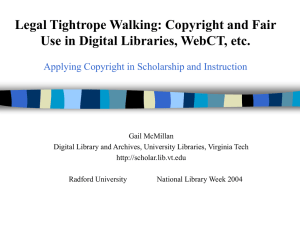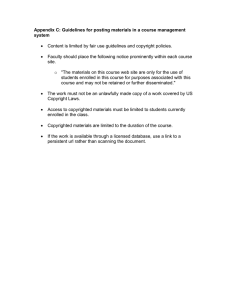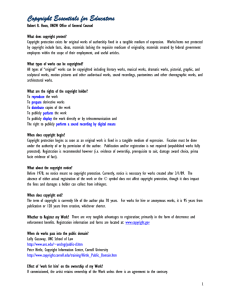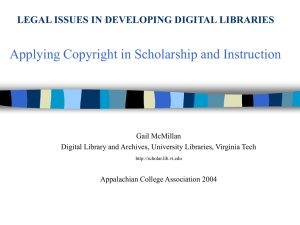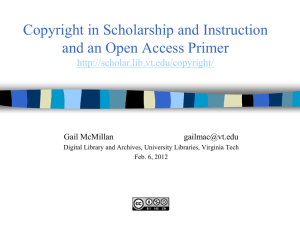Applying Copyright in Scholarship and Instruction
advertisement
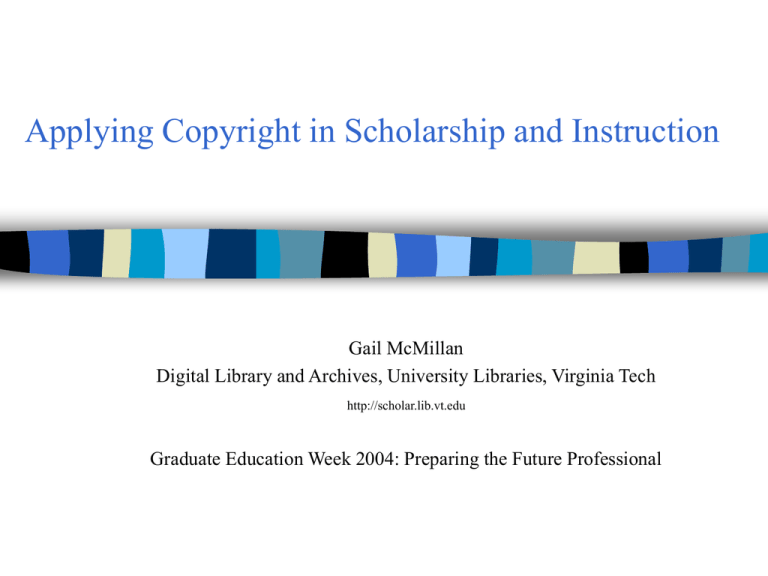
Applying Copyright in Scholarship and Instruction Gail McMillan Digital Library and Archives, University Libraries, Virginia Tech http://scholar.lib.vt.edu Graduate Education Week 2004: Preparing the Future Professional Copyright Law: U.S. Code, Title 17 © © Section 102: Original authorship stabilized Section 106: Exclusive rights of creators Limitations to exclusive rights © Section 107: Fair use © Section 108: Library services © Section 110: Instruction--TEACH Act – http://www.law.cornell.edu/uscode/17/ Who owns the copyright? Creators of original works Creators' assignees Employers: works for hire As of March 1, 1989, the copyright warning does not have to appear on a work for it to be legally copyrighted. © 2003 by Gail McMillan “Permission is given to copy this work provided credit is given and copies are not intended for sale.” Why officially register your copyright? Possibly receive greater compensation, with less documentation when filing an infringement suit Rights of copyright holders 1. Reproduction 2. Modification 3. Distribution 4. Public performance 5. Public display Title 17 U.S.C. Sec. 106 Permission or license to use a copyrighted work is NOT required if Work is a fact or an idea – Phone number, earth is round Public domain – US; very, very old Fair use – http://www.utsystem.edu/OGC/IntellectualProperty/copypol2. htm#test – TEACH Act Public Domain Lolly Gassaway: http://www.unc.edu/~unclng/public-d.htm DATE OF WORK PROTECTED FROM Created 1-1-78 or after Published before 1923 When work is fixed in tangible medium of expression In public domainК Published from 1923 - 63 When published with notice3 Published from 1964 - 77 When published with notice 1-1-78, the effective date of the 1976 Act which eliminated common law copyright Created before 1-1-78 but not published Created before 1-1-78 but published between then and 12-312002 1-1-78, the effective date of the 1976 Act which eliminated common law copyright TERM Life + 70 years1(or if work of corporate authorship, the shorter of 95 years from publication, or 120 years from creation2 None 28 years + could be renewed for 47 years, now extended by 20 years for a total renewal of 67 years. If not so renewed, now in public domain 28 years for first term; now automatic extension of 67 years for second term Life + 70 years or 12-312002, whichever is greater Life + 70 years or 12-31-2047 whichever is greater Fair Use © Myth: It's OK--it's for educational purposes. Before using someone else's work without permission, weigh ALL 4 FACTORS 1. Purpose and character of use 2. Nature of the copyrighted work 3. Amount, substantiality 4. Effect Title 17 U.S.C. Sec. 107 1. Purpose and character of use Commercial or educational use For profit or not Degree of transformation; value added For criticism, commentary, news reporting, teaching, scholarship, research FAIR USE 1 of 4 Purpose and character of use FAVORS FAIR USE Nonprofit Educational Personal EITHER Criticism Commentary News reporting Parody Other transformative use FAVORS © OWNER Commercial 2. Nature of the copyrighted work Worthy of (extensive) protection? Character of the work? – fact (information) or fiction (imaginative) • Published facts weigh in favor of fair use • Unpublished original expressions weigh in favor of seeking permission FAIR USE 2 of 4 Is the letter you wrote to your high school sweetheart his/hers to publish? TRUE or FALSE? 3. Amount and substantiality Use only what is necessary Quantity and quality in relation to whole work FAIR USE 3 of 4 Do you own the copyright to the email you receive? TRUE or FALSE? 4. Effect Harm to potential market or value of a work after a portion has been used separately from the whole FAIR USE 4 of 4 It's publicly available on the web so I can use it without asking. True or False? It's OK to use someone else’s work as long as I give proper attribution. It’s like free advertising. True or False Fair use Did the scales tip in your favor after weighing all 4 factors? If not – Ask for permission – Use library services Copyright permission services Copyright Clearance Center – copyright.com RSiCopyright – www.icopyright.com/ Association of American Publishers – www.publishers.org You asked but they never responded. You don’t have permission. Libraries and Title 17 U.S.C. Sec. 108 or, Why the library can but you can’t Open to the public or to others doing research Notice of copyright Reproduction or distribution without profit Reserve Services – Copying articles, chapters – Limiting to university community – Limiting to one term, not sequential Course Management Systems University Libraries’ Policies http://scholar.lib.vt.edu/copyright/ EReserve and Reserve (merging) ETDs (Electronic Theses and Dissertations) – Request Publisher's Permission to Use Copyrighted Works. – You don’t have to give away all your rights to get published. ILL (InterLibrary Loan) and Document Delivery Center for Alternative Media (moved to Circulation) – Fair Use of educational multimedia – CCUMC Consortium of College and University Media Centers Photocopy Warning – Post warning re © restrictions (law) Copyright for Instruction USC Title 17 Section 110 – Limitations of certain performances and displays – Face-to-face classroom settings Broadened by TEACH Act (Nov. 2, 2002) – Must have an institutional policy in order to invoke the TEACH Act Don’t forget: apply fair use (all 4 factors) TEACH: Technology Education and Copyright Harmonization Act Fair use standards in digital education environment Modifies existing copyright law for: – – – – – – Accredited nonprofit educational institution Mediated instruction Integral part of class session Limited to enrolled students Accurately informed about copyright compliance Reasonably prevent • Retention beyond course • Unauthorized further dissemination TEACH Act: Works allowed Show entire nondramatic literary works – News, poetry, speech, charts, maps Show entire nondramatic musical works Everything else in reasonable and limited portions – Plays, movies, operas, TV shows, choreography USE IN DISTANCE LEARNING CLASS THE SAME AS IF IN THE CLASSROOM TEACH Act--You must not use Works marketed primarily for distance education Unlawfully made or acquired copies Materials meant for additional study outside of class – EReserve, Reserve, course management systems TEACH Act--You must Transmit as an integral part of class session regular part of systematic, mediated instruction Use copyrighted materials only when directly related to the lesson Limit access to students enrolled in the course Have an institutional copyright policy & inform students about © Block further dissemination Copyright Resources Copyright Management Center (IUPUI) – http://www.copyright.iupui.edu/dist_learning.htm Crash Course in Copyright (UTAustin) – http://www.utsystem.edu/OGC/IntellectualProperty/cprtindx.htm Library of Congress, Copyright Office – http://lcweb.loc.gov/copyright/ Legal Information Institute (Cornell) – http://www4.law.cornell.edu/uscode/17/ Stanford University Libraries – http://fairuse.stanford.edu TEACH Toolkit – http://www.lib.ncsu.edu/scc/legislative/teachkit/guidelines.html Additional comments/discussion? Applying Copyright in Scholarship and Instruction Gail McMillan: gailmac@vt.edu Digital Library and Archives, University Libraries, Virginia Tech http://scholar.lib.vt.edu Graduate Education Week 2004: Preparing the Future Professional
